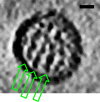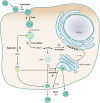A global perspective on hantavirus ecology, epidemiology, and disease
- PMID: 20375360
- PMCID: PMC2863364
- DOI: 10.1128/CMR.00062-09
A global perspective on hantavirus ecology, epidemiology, and disease
Abstract
Hantaviruses are enzootic viruses that maintain persistent infections in their rodent hosts without apparent disease symptoms. The spillover of these viruses to humans can lead to one of two serious illnesses, hantavirus pulmonary syndrome and hemorrhagic fever with renal syndrome. In recent years, there has been an improved understanding of the epidemiology, pathogenesis, and natural history of these viruses following an increase in the number of outbreaks in the Americas. In this review, current concepts regarding the ecology of and disease associated with these serious human pathogens are presented. Priorities for future research suggest an integration of the ecology and evolution of these and other host-virus ecosystems through modeling and hypothesis-driven research with the risk of emergence, host switching/spillover, and disease transmission to humans.
Figures




References
-
- Ahlm, C., P. Juto, B. Stegmayr, B. Settergren, G. Wadell, A. Tarnvik, and F. Elgh. 1997. Prevalence of serum antibodies to hantaviruses in northern Sweden as measured by recombinant nucleocapsid proteins. Scand. J. Infect. Dis. 29:349-354. - PubMed
-
- Ahlm, C., A. Thelin, F. Elgh, P. Juto, E. L. Stiernstrom, S. Holmberg, and A. Tarnvik. 1998. Prevalence of antibodies specific to Puumala virus among farmers in Sweden. Scand. J. Work Environ. Health 24:104-108. - PubMed
Publication types
MeSH terms
Grants and funding
LinkOut - more resources
Full Text Sources
Other Literature Sources
Medical

